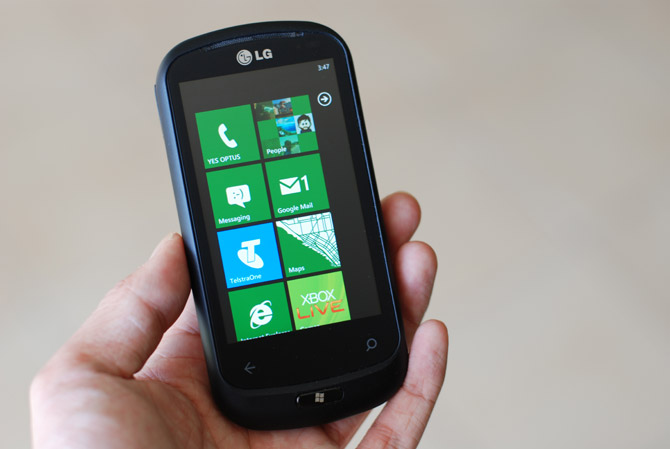
It’s hard not to fall in love with Windows Phone 7. From a distance, WP7 is undeniably fresh in a sea of familiar faces. Up close, it’s invitingly simple yet can still put a smile on your face with little gems of interactive delight; not unlike a product from Apple.
Although not the fault of the software by any means, as I’ve found after my week-long use, Australian users will be getting the short end of the stick with some essential service-based functionality watered down. Having said that, this is a great product even at the lowest common denominator.
Since the Microsoft press conference on October 12, I’ve been using an LG Optimus 7Q (also known as the LG Quantum in the US) as my only mobile phone. Bear in mind this particular handset is a pre-production device so I won’t make any judgements on the hardware, still, Windows Phone 7 shines.
It’s hard to believe just how Microsoft pulled off this hat trick considering the core of this OS, Windows CE, is what too made Windows Mobile tick, or more precisely, fail to tick. The result is not only a shell that’s comparable in usability and performance to the iPhone and Android, but also matches if not exceeds the expectations for a great mobile experience.
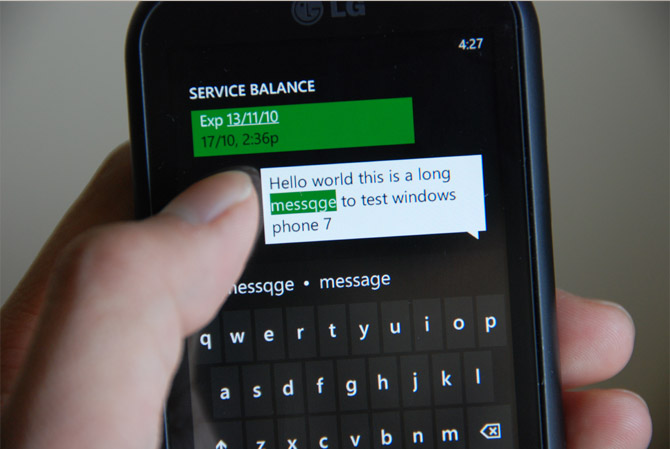
A prime example is the on-screen keyboard which is an absolute thrill to type on. Going above and beyond expectations for the few times when the prediction is wrong, instead of pretending it’s perfect, you can simply choose any word you’ve typed and reselect from the choices. Brilliant.
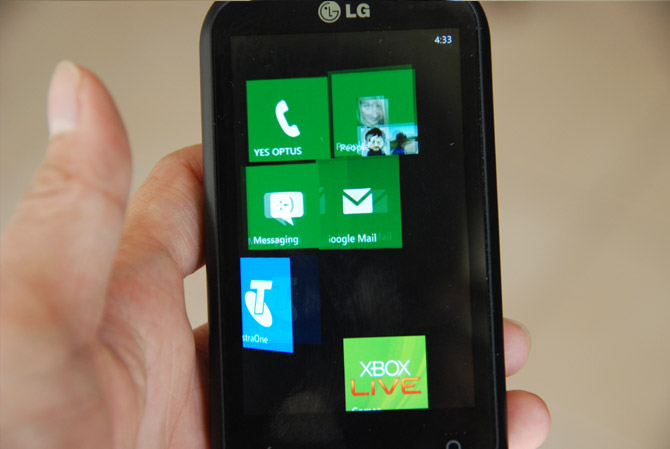
The Metro design language may have captured a lot of people’s attending with its elegant combination of text and solid colors through screenshots, but in practice, the animations are the icing on the cake.
If you have a thing for subtleties like me, you will very well find yourself tapping in and out of applications just to see tiles fold away and back for minutes on end. It’s not just eye candy too. The transitions adds a sense of fluidity between actions that helps the OS feel more responsive.
Out of the box, Windows Phone 7 delivers a lot of functionality. The usual suspects of a mobile platform – email, calendaring, music and photos are first-class experiences as you might expect.
Whether you get one or fifty pieces of email a day, you’ll find the email application makes reading and managing emails a painless if not slick experience with the aforementioned animations. It might sound childish but watching a deleted email sucked down and sent emails fly up makes me smile every time.
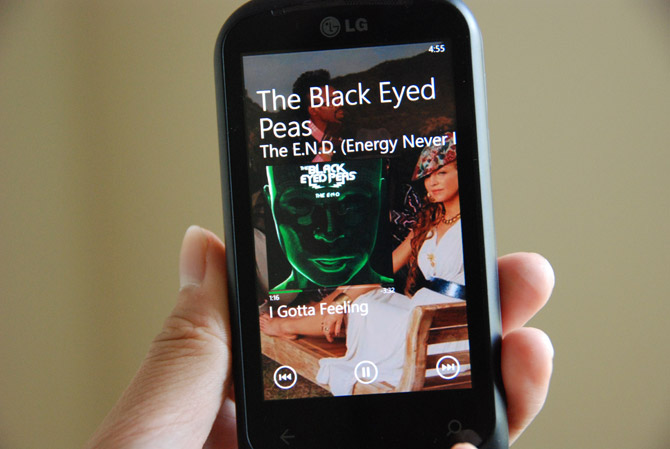
The Zune app for managing music, video and podcasts is quite easily one of the better mobile media experiences. The best thing about it though is the automatic WiFi syncing when you charge at home which means it syncs as often as it should, not just when you can be bothered to plug it in to the computer. For me, that is almost never.
Besides the given, there’s also the unexpected. The Office 2010 suite of apps are feature-rich yet practical for a mobile device which will prove useful for both enterprise-heavy users and the occasional note taker through OneNote. Even Internet Explorer (Mobile 7) makes an impressive effort as a confident mobile browser. I’ll be lying to claim it’s the best, but it should stand the test of casual mobile browsing.
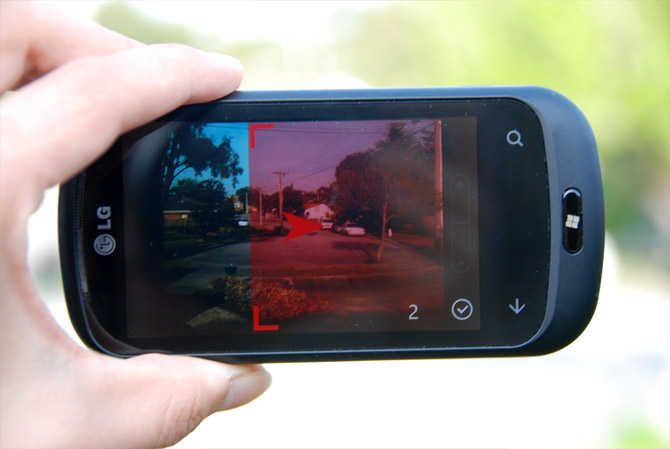
For the app-minded, the Marketplace already houses a library of applications and games of varying quality and functionality. There is the stupid, like a $0.99 farting dinosaur app. At the other end of the spectrum, there is an innovative LG-exclusive panorama photo app that takes advantage of the compass and works quite well if you try hard enough. Plus, everything in-between.
What’s important to note though is that there is a lot of potential in this platform for great looking, useful and rewarding applications and games. The marketplace might take up to half a year to mature but there is definitely momentum from both companies porting their popular applications across from other platforms and new developers breaking new ground.
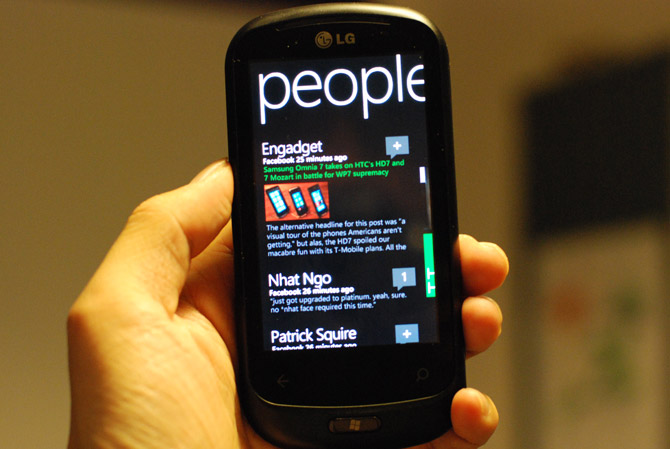
Granted the idea of integrating social networks on the phone is not an entirely new concept, Microsoft’s implementation on Windows Phone 7 is actually pretty compelling. The Facebook stream and other Windows Live-connected social feeds from the people you care most about are available right then and there just when you need them, without stepping in and out a plethora of apps.
The best example of where this integration is unrivaled is in the “Photos” hub. In there, shared pictures from all your contacts are collated from a range of social networks and web services through Windows Live in a single view. Compared to navigating through half a dozen websites or apps to see them all, it’s a no brainer.
Unfortunately, the web search feature, Maps application, voice search and the music marketplace is where the road gets a little bit bumpy for Windows Phone 7 in Australia. At launch, all of these experiences are crippled one way or another. And in the case of the Zune (music), it’s missing entirely.

As illustrated above, in it’s default configuration Windows Phone 7 does not return any local results in either the Bing app or Maps. If you searched for “McDonalds” with the map centered anywhere in Australia, you will be transported half way around the world to the United States. And because Microsoft is locking the search functionality to Bing indefinitely, this has long-term implications.
Although the cause for these region-specific inconveniences is the result of market segmentation by Bing and Zune, Windows Phone 7 will suffer the blame for a poor searching and entertainment experience in Australia. Luckily though I have discovered a workaround to ease some of the pain until Microsoft addresses them, eventually (I hope).
In light of a few issues, Windows Phone 7 has a lot going for it. It’s a well rounded experience from day one and will only get better with time. At the same time, Apple and Google aren’t going to let their platforms fall behind either so don’t expect Windows Phone to stay dormant for as long as it did ever again.
One thing’s for sure though, Microsoft has caught up to the rest of the pack and the race is on.
When will Redmond learn that there is life outside of the US? Should I cancel my pre-order of an HD7 to avoid disappointment when the same regional shortcomings show up in Canada?
What are you talking about? Their launching in Asia and Europe 2 weeks before the North American launch! In fact, it was released first in New Zealand of all countries!
Certainly give that to the marketing team, but in the long run having only a subset of the features, especially when the content exists as pointed out on another post is going to be quite frustraiting. Not to mention the lack of a Zune Pass (at least in Canada)…
Blame Canadian copyright holders for no zune pass, not Microsoft. I was looking at the newly launched netflix unlimited HD streaming service in Canada and the Catalog is 1/10th of what it is in the states due to license restrictions.
I thought Windows Mobile 7 was a complete rewrite and does not use the Windows CE core. Is this not true?
Windows Phone 7 a complete rewrite of the Windows Mobile shell but the core is still Windows CE. You can tell because if you dump the emulator image, you’ll find CE kernel files – a newer version of the ones that are used in Windows Mobile 6.5
To be specific the WP7 OS 1.0 is based in WIn CE 6 R3 + some elements of WEC7.
SL running in WP7 while the same as the one from the desktop is not full SL4 but more like a SL3.5. IEM7 is based on a mix of the desktop IE8 compatibility mode (IE7 mode) + some IE9 features (subpixel positioning, etc).
Off topic here, but where you in the Telstra store in Melbourne today at about 11-1pm?
Me? No. Didn’t go out today.
Oh ok, must of been someone else then hehe.
Well I tested out the display model that Telstra was showing: the HTC Mozart, verdict: amazing! just blown away by how smooth the interface was, I will definitely be buy a winpho7 in the near future. Though I’m still unsure what model of phone I should buy
I’m trying to get the other WP7 devices in the range to compare them side by side, but I think the Samsung Omnia 7 is the best at the moment.
Too bad that in Australia you can’t actually purchase them yet. I wanted to purchase the HTC Trophy so I called several vodafone stores and they hadn’t even heard of the phone. There are only a handful of Telstra stores that have a few units as well. Pretty sad state for a launch, they should of launched them when they’d actually have them available for sale!
Anyone else here who finds it annoying that the 3rd Party software don’t follow your chosen tile color?
Example, 1st and 3rd Screenshot, the Telestra Tile has a “hard-coded” light blue background. I hate lazy developers who do Not pay attention to details like these. This is why I’m still waiting for the next iteration of Windows Phone 7. Microsoft should educate the vendors about these small details, and behave like Apple!
Worse, the Zune desktop software encourages developers the wrong way. Developers that actually pay enough attention to make a transparent background icon will have their app virtually invisible, since the icon is white and Zune’s background is also white.
Way to go for punishing people doing the right thing, Microsoft! Please fix this!
You can change the back-round color of your Zune PC software in the settings.
That’s not really true – that’s just a mistake some developers made because they didn’t know any better.
The icons you create for the phone can use transparency – you just have to remember to remove the transparent regions from the versions of the icons you submit to be used in the catalog, or light colors in the non-transparent regions of the versions submitted to be used in the catalog.
@Long, I am confused between HTC HD7 and Samsung Omina 7. Which one you think is better?
I think the AMOLED screen of the Samsung Omnia 7 is worth it more than the screen size on the HTC HD7.
Somewhat miffed at the lack of handsets from Optus and Vodafone. Absolutely zero effort, even Telstra was a pretty bad showing. And as for bing-regional issues, that just takes the biscuit. What are they playing giving people problems like that. When oh when will they learn, we all don’t live in the USA.
“Microsoft has caught up to the rest of the pack…”
Walt Mossberg from the Wall Street Journal doesn’t seem to think so: http://bit.ly/bdcret
Because of course Walt Mosspuppet is going to say something positive about it…
well… he actually does say quite a bit of positive stuff about it. He actually says Microsoft’s approach is fresh and new and rather than emulating or copying the other smart phones in the market they try something new.
But he believes Microsoft still has quite a bit more catching up to do as they have left out a number of features he believes users expect these days.
Perhaps you should have watched the video instead of jumping to conclusions.
So, according to Mossberg, because WP7 failed to open a corrupted Word doc and because it doesn’t yet support copy & paste and tethering it’s “an inferior choice for most users”. Considering iPhone users got by just fine fo over 2.5 years without copy and paste speaks volumes about how important this feature is to “most users”. And, c’mon, seriously, how often do people use their phones for internet access from their laptops? I estimate that < 1% of people tether right now. If it increases in popularity, then there's no reason why MS can't add this as a feature to future updates.
Walt is a biased ABM shill. Nothing more.
Long, will you please tell me if Windows Phone 7 supports 63 characters long ASCII passphrase for WPA2-PSK which is the longest length you can have for Wi-fi. Zune HD supports only 31 characters long passphrase maximum so I forced to reduce the passphrase length on my home network. Is the way to set up wireless sync the same-Zune software?
Long (or anyone), does WP7 support WS2008R2 Remote Desktop Gateway and Remote Apps?
Loads of advertised features are missing in most markets and in basic smartphone functionality they’re at the point where the competition was in 2007. You’re right, what’s -not- to love about it?
Can you honestly say that WP7 is on par with the competition with -anything- apart from the UI design?